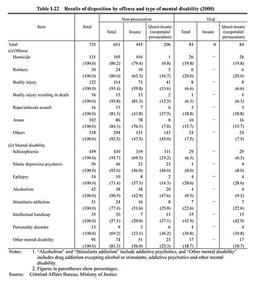| Previous Next Index Image Index Year Selection | |
|
|
2. Disposition by public prosecutors offices and courts for offenses committed by mentally disabled persons, etc. Table I-21 shows the trends in the numbers of suspects who were treated as insane or quasi-insane persons and not prosecuted by public prosecutors offices as well as those who were found not-guilty on the grounds of being insane or given a reduced sentence on the grounds of being quasi-insane by first instance during the last five years from 1996 to 2000.
In 2000, 436 out of 735 insane and quasi-insane persons were involuntarily admitted to mental hospital, and 64 were sentenced to imprisonment without suspension of execution of sentence or taken into custody (see Appendix I-7 ). Table I-21 Number of insane and quasi-insane persons (1996-2000) Table I-22 shows the reasons for non-prosecution and the results of trials for mentally disabled offenders, by type of offense and type of mental disability. By offense, 131 out of 735 insane and quasi-insane persons committed homicide, accounting for the largest share (17.8%).By mental disability, most of those persons (459 persons) suffered from schizophrenia (62.4% of the total). Persons suffering from schizophrenia accounted for 75.0% of offenders of bodily injury resulting in death, 68.8% of rape/indecent assault offenders, and 68.7% of homicide offenders (see Appendix I-8 ). Table I-22 Results of disposition by offense and type of mental disability (2000) |

